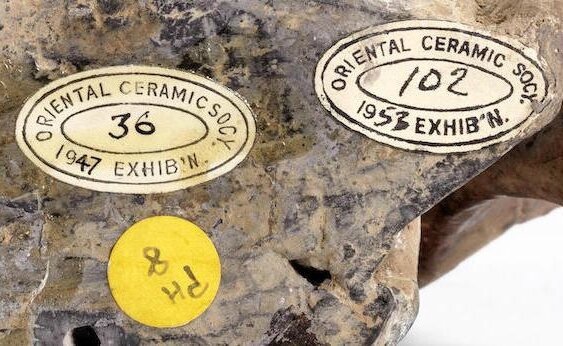The well-modelled figure wearing a long belted robe with flaring sleeves and loose trousers, vividly depicted with his head and body gently leaning towards the left, both legs bent, the right arm partially raised and the left hand closed as if strumming a pipa, the face with a serene expression and hair gathered in a high knot, with traces of gilding and polychrome pigments. 26.1cm (10 1/4in) high
Provenance: Rolf, Lord Cunliffe (1899-1963), Honorary Keeper of the Far Eastern Collections at the Fitzwilliam Museum, Cambridge
C.W. Moller Collection
Sotheby's London, 13 December 1946, lot 27
Acquired from Bluett & Sons Ltd., London, 11 January 1947
The Cunliffe Collection, no.PH8, and thence by descent
Exhibited and Published: Oriental Ceramic Society, Two Thousand Years of Chinese Ceramic Figures, London, 8 April - 21 June 1947, no.36
Oriental Ceramic Society, Pre-T'ang Wares, London, 29 April - 10 June 1953, no.102
Notes: Music was extremely popular in the Tang dynasty. Institutions were set up to oversee the training and performances of music and dances in the Imperial court such as the Great Music Bureau and the Drums and Pipes Bureau. Tang court music was mainly based on the tuning of the Kuchean lute and drum and thousands of musicians housed within the walls of the Imperial Palace were trained to perform orchestral pieces drawing from Central Asian influences. For reference, see L. Picken, Music from the Tang Court, Cambridge, 1985.
Related examples of Tang musicians are illustrated by R. Krahl, Collection Julius Eberhardt, Early Chinese Art, Hong Kong, 1999, pl. 125 and in Galerie Lafayette, Les Tresors de la Dynasty Tang, Paris, 1993, cat. no. 6.
Bonhams. AUCTION 23237: FINE CHINESE ART, 10:30 BST - LONDON, NEW BOND STREET

/https%3A%2F%2Fprofilepics.canalblog.com%2Fprofilepics%2F1%2F0%2F100183.jpg)
/https%3A%2F%2Fstorage.canalblog.com%2F03%2F02%2F119589%2F96711876_o.jpg)
/https%3A%2F%2Fstorage.canalblog.com%2F11%2F31%2F119589%2F94773502_o.jpg)
/https%3A%2F%2Fstorage.canalblog.com%2F20%2F83%2F119589%2F94772815_o.jpg)
/https%3A%2F%2Fstorage.canalblog.com%2F26%2F72%2F119589%2F75604929_o.jpg)
/https%3A%2F%2Fstorage.canalblog.com%2F59%2F60%2F119589%2F26458628_o.jpg)




/http%3A%2F%2Fstorage.canalblog.com%2F75%2F49%2F119589%2F129758853_o.jpg)
/http%3A%2F%2Fstorage.canalblog.com%2F93%2F40%2F119589%2F129411239_o.jpg)
/http%3A%2F%2Fstorage.canalblog.com%2F17%2F14%2F119589%2F129411215_o.jpg)
/http%3A%2F%2Fstorage.canalblog.com%2F33%2F92%2F119589%2F129411180_o.jpg)